Abstract
1. The possible interaction (as indicated by rat experiments) between calcium channel blocking agents and benzodiazepines has been evaluated in nine healthy subjects. 2. Subsequently to an intravenous loading dose (0.07 mg kg-1) midazolam was infused for 6 h (0.035 mg kg-1 h-1) and steady state plasma levels between 54 to 114 micrograms l-1 were achieved. Two hours after the bolus of midazolam a solution of 20 mg nitrendipine or placebo was administered in a randomized, double-blind crossover fashion. 3. The marked sedative-hypnotic effects of midazolam as assessed by visual analogue scales (about four fold increase in the sedation index) and choice reaction time (100% prolongation) indicated some form of adaptation or tolerance towards the end of the infusion. However, the midazolam-induced impairments were not affected by nitrendipine. 4. EEG-data indicated stabile benzodiazepine-like effects during the complete infusion period of midazolam (e.g. decrease in alpha activity, increase in sigma, delta 2 and beta 1 activity). Again, these alterations were not modified by nitrendipine. 5. There was also no pharmacokinetic interaction between both agents, since elimination of midazolam (t 1/2 = 2.5 +/- 0.8 h; CL = 548 +/- 143 ml min-1) was in close agreement with control values (t 1/2 = 2.4 +/- 0.6 h; CL = 512 +/- 102 ml min-1). Likewise, plasma levels of nitrendipine were comparable to literature data. 6. Thus, it could be concluded that nitrendipine does not affect the action of midazolam and therefore a direct involvement of calcium at the benzodiazepine receptor site is unlikely under our clinical conditions.
Full text
PDF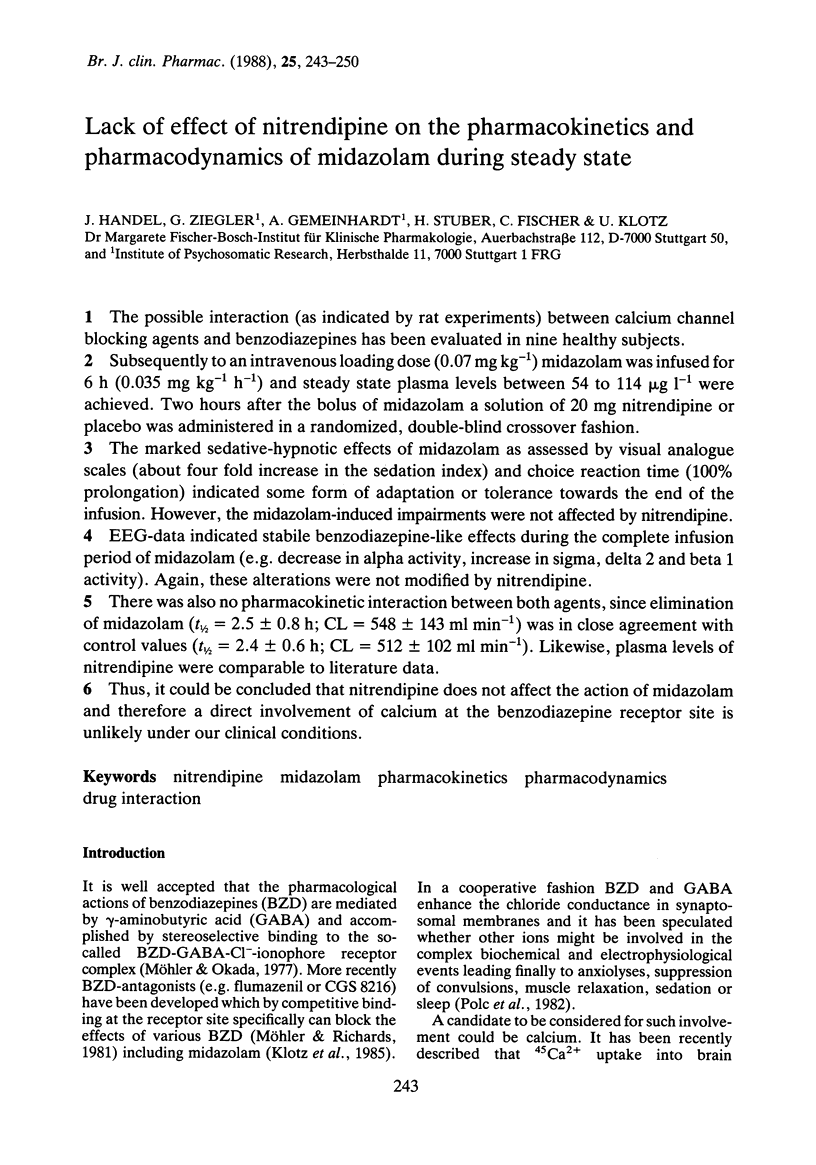

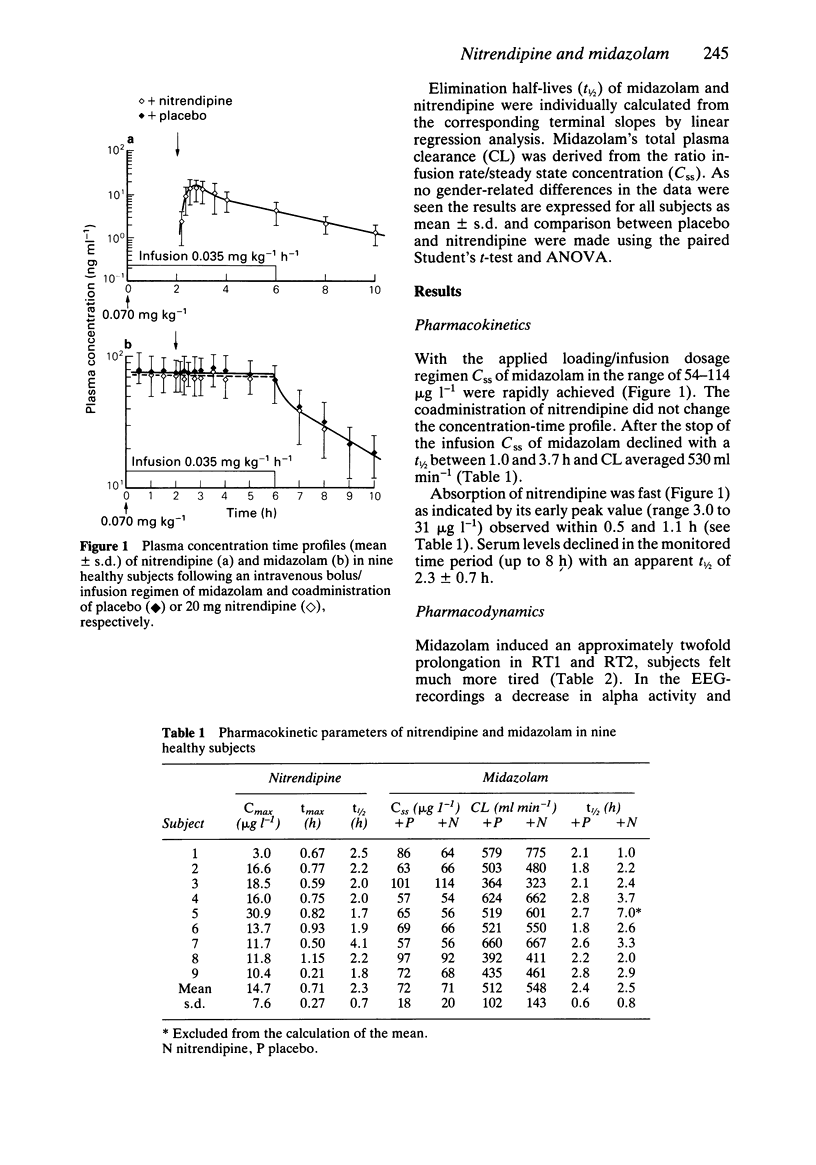


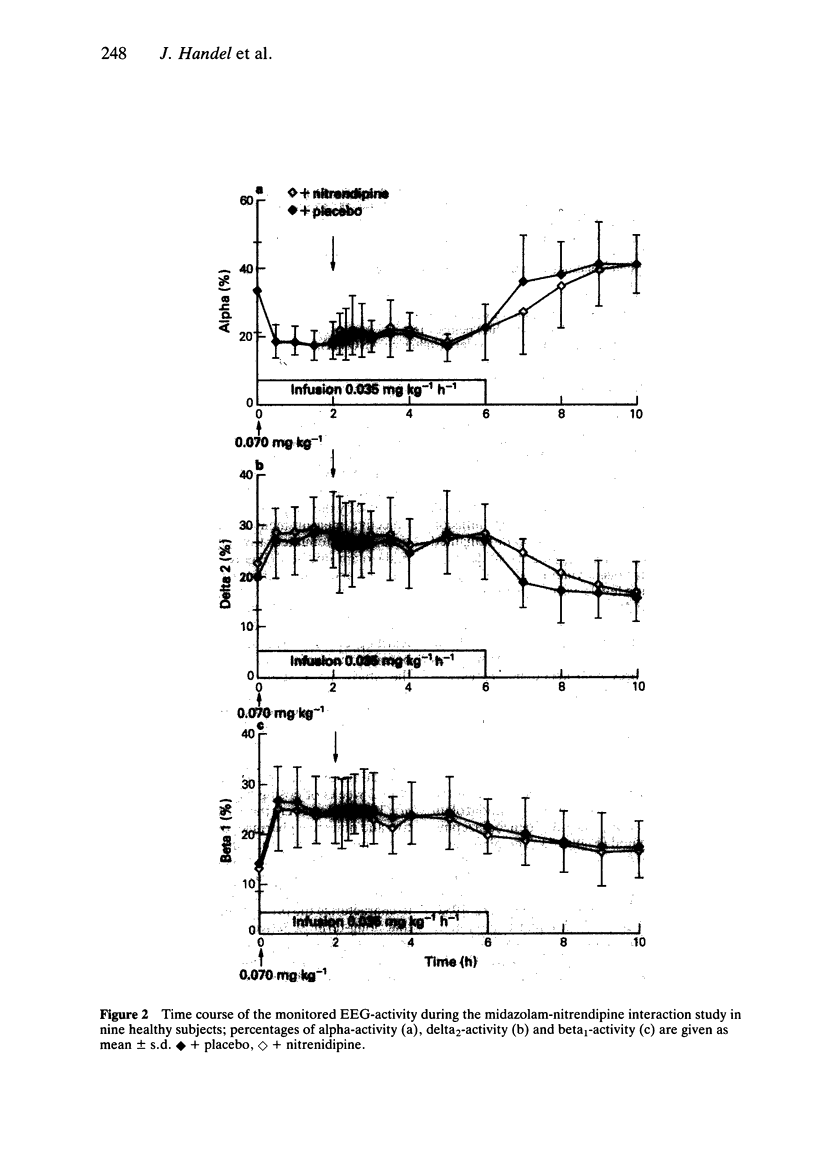
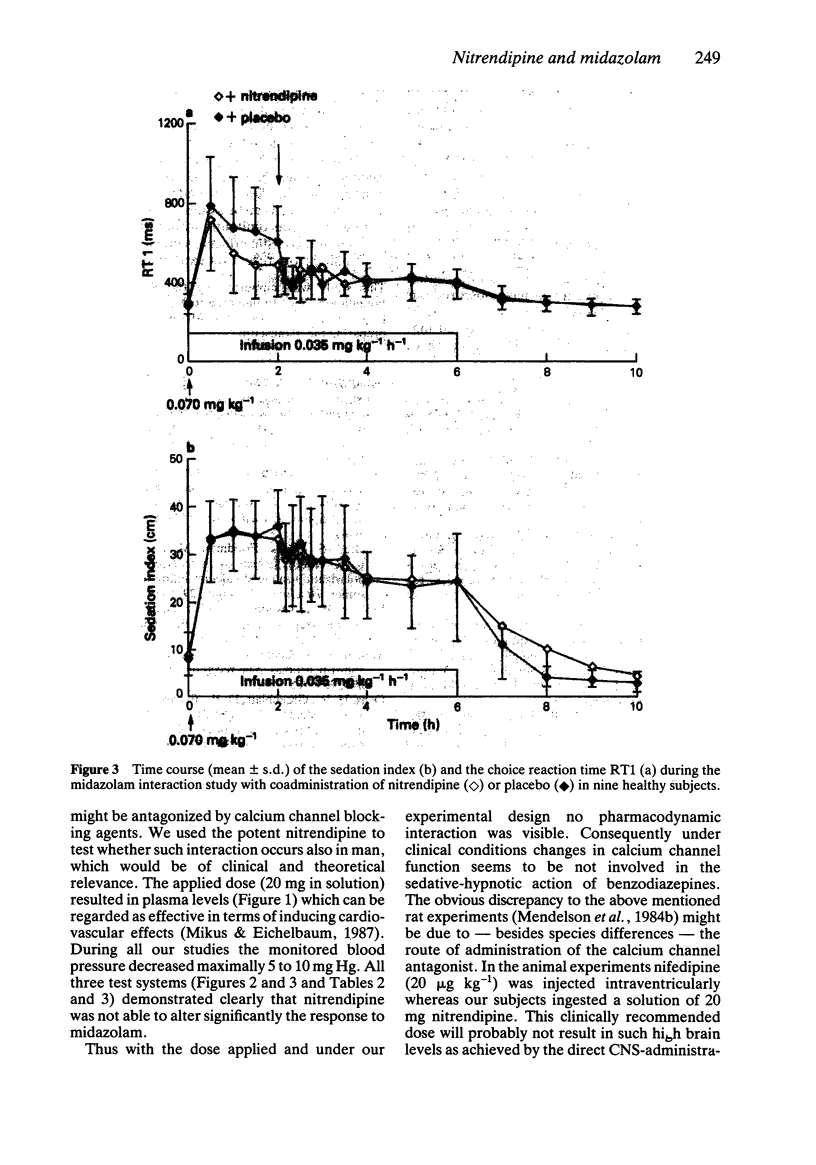
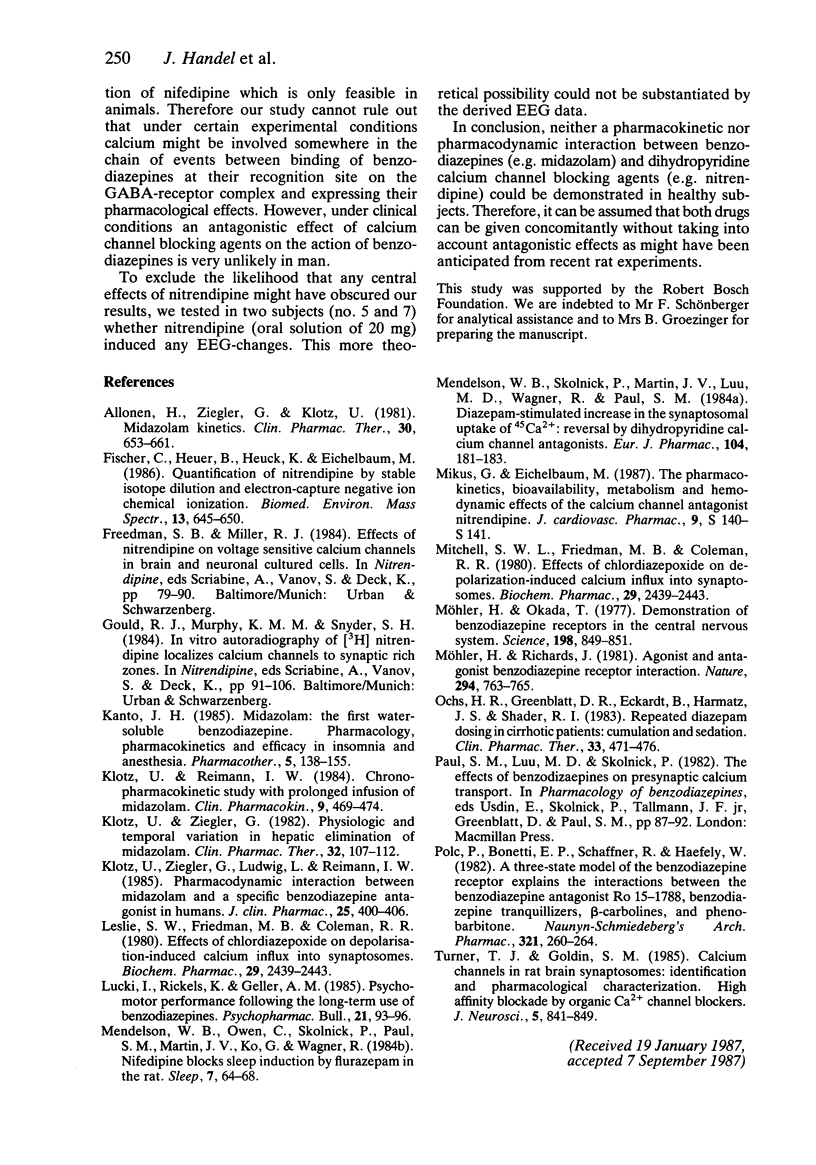
Selected References
These references are in PubMed. This may not be the complete list of references from this article.
- Allonen H., Ziegler G., Klotz U. Midazolam kinetics. Clin Pharmacol Ther. 1981 Nov;30(5):653–661. doi: 10.1038/clpt.1981.217. [DOI] [PubMed] [Google Scholar]
- Fischer C., Heuer B., Heuck K., Eichelbaum M. Quantification of nitrendipine by stable isotope dilution and electron-capture negative ion chemical ionization. Biomed Environ Mass Spectrom. 1986 Dec;13(12):645–650. doi: 10.1002/bms.1200131202. [DOI] [PubMed] [Google Scholar]
- Kanto J. H. Midazolam: the first water-soluble benzodiazepine. Pharmacology, pharmacokinetics and efficacy in insomnia and anesthesia. Pharmacotherapy. 1985 May-Jun;5(3):138–155. doi: 10.1002/j.1875-9114.1985.tb03411.x. [DOI] [PubMed] [Google Scholar]
- Klotz U., Reimann I. W. Chronopharmacokinetic study with prolonged infusion of midazolam. Clin Pharmacokinet. 1984 Sep-Oct;9(5):469–474. doi: 10.2165/00003088-198409050-00006. [DOI] [PubMed] [Google Scholar]
- Klotz U., Ziegler G., Ludwig L., Reimann I. W. Pharmacodynamic interaction between midazolam and a specific benzodiazepine antagonist in humans. J Clin Pharmacol. 1985 Sep;25(6):400–406. doi: 10.1002/j.1552-4604.1985.tb02866.x. [DOI] [PubMed] [Google Scholar]
- Klotz U., Ziegler G. Physiologic and temporal variation in hepatic elimination of midazolam. Clin Pharmacol Ther. 1982 Jul;32(1):107–112. doi: 10.1038/clpt.1982.133. [DOI] [PubMed] [Google Scholar]
- Leslie S. W., Friedman M. B., Coleman R. R. Effects of chlordiazepoxide on depolarization-induced calcium influx into synaptosomes. Biochem Pharmacol. 1980 Sep 15;29(18):2439–2443. doi: 10.1016/0006-2952(80)90347-0. [DOI] [PubMed] [Google Scholar]
- Leslie S. W., Friedman M. B., Coleman R. R. Effects of chlordiazepoxide on depolarization-induced calcium influx into synaptosomes. Biochem Pharmacol. 1980 Sep 15;29(18):2439–2443. doi: 10.1016/0006-2952(80)90347-0. [DOI] [PubMed] [Google Scholar]
- Lucki I., Rickels K., Geller A. M. Psychomotor performance following the long-term use of benzodiazepines. Psychopharmacol Bull. 1985;21(1):93–96. [PubMed] [Google Scholar]
- Mendelson W. B., Owen C., Skolnick P., Paul S. M., Martin J. V., Ko G., Wagner R. Nifedipine blocks sleep induction by flurazepam in the rat. Sleep. 1984;7(1):64–68. doi: 10.1093/sleep/7.1.64. [DOI] [PubMed] [Google Scholar]
- Mendelson W. B., Skolnic P., Martin J. V., Luu M. D., Wagner R., Paul S. M. Diazepam-stimulated increases in the synaptosomal uptake of 45Ca2+: reversal by dihydropyridine calcium channel antagonists. Eur J Pharmacol. 1984 Sep 3;104(1-2):181–183. doi: 10.1016/0014-2999(84)90388-1. [DOI] [PubMed] [Google Scholar]
- Möhler H., Okada T. Benzodiazepine receptor: demonstration in the central nervous system. Science. 1977 Nov 25;198(4319):849–851. doi: 10.1126/science.918669. [DOI] [PubMed] [Google Scholar]
- Möhler H., Richards J. G. Agonist and antagonist benzodiazepine receptor interaction in vitro. Nature. 1981 Dec 24;294(5843):763–765. doi: 10.1038/294763a0. [DOI] [PubMed] [Google Scholar]
- Ochs H. R., Greenblatt D. J., Eckardt B., Harmatz J. S., Shader R. I. Repeated diazepam dosing in cirrhotic patients: cumulation and sedation. Clin Pharmacol Ther. 1983 Apr;33(4):471–476. doi: 10.1038/clpt.1983.64. [DOI] [PubMed] [Google Scholar]
- Polc P., Bonetti E. P., Schaffner R., Haefely W. A three-state model of the benzodiazepine receptor explains the interactions between the benzodiazepine antagonist Ro 15-1788, benzodiazepine tranquilizers, beta-carbolines, and phenobarbitone. Naunyn Schmiedebergs Arch Pharmacol. 1982 Dec;321(4):260–264. doi: 10.1007/BF00498510. [DOI] [PubMed] [Google Scholar]
- Turner T. J., Goldin S. M. Calcium channels in rat brain synaptosomes: identification and pharmacological characterization. High affinity blockade by organic Ca2+ channel blockers. J Neurosci. 1985 Mar;5(3):841–849. doi: 10.1523/JNEUROSCI.05-03-00841.1985. [DOI] [PMC free article] [PubMed] [Google Scholar]


